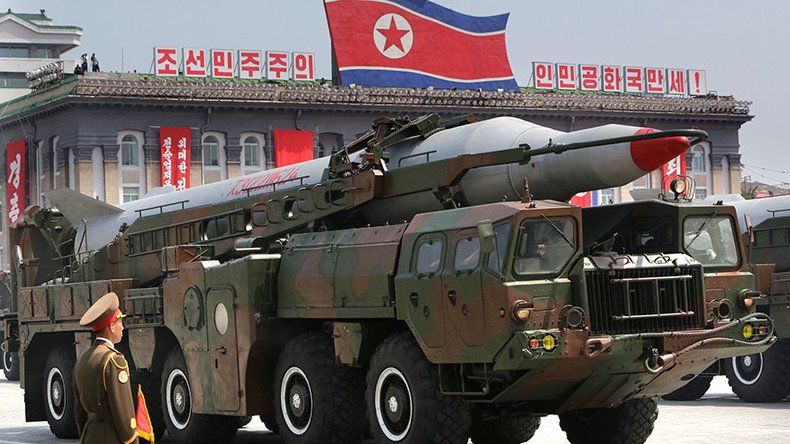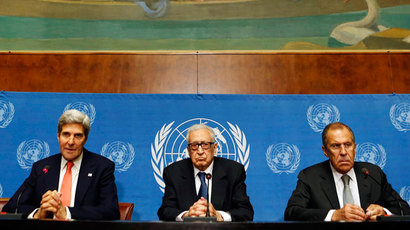Washington’s role in turning N. Korea into military garrison state

Amid the ocean of analyses of North Korea produced over the years, you will struggle to find one that identifies US foreign policy as a key factor in the country’s regressive development.
This is the point consistently abstracted when it comes to arriving at an accurate rendering of a state consistently depicted as a veritable hell, in which its 25 million citizens are kept in a state of permanent fear and terror, a state and society in which human rights are non-existent, along with any vestige of freedom of expression or conscience.
While this is certainly part of the story when it comes to North Korea, it is by no means the whole story. For that we need to understand the concrete historical conditions that have largely, though not solely, been responsible for its current mode of existence as a garrison state.
North Korea emerged from the Second World War along with South Korea as symptoms of a cold war that pitted the capitalist West, led by Washington, against the communist East, led by Moscow. The Korean Peninsula had been brutally occupied and colonized by the Japanese during the war. In the process of defeating the forces of Imperial Japan, Soviet forces penetrated into the north and US forces moved into the south, agreeing a demarcation line along the 38th parallel. In contravention of a UN plan to hold all-Korean elections, South Korea was formally established in May 1948, followed by the creation of North Korea in September 1948.
‘No one to benefit from war on Korean peninsula’: World reacts to N.Korea’s latest nuke test https://t.co/t0dOoGAhNLpic.twitter.com/OTAWGQeUax
— RT (@RT_com) 9 сентября 2016 г.
The newly established state of North Korea was led by Kim Il-sung, a man who achieved high status as a result of his role in resisting the Japanese occupation of China and Korea throughout the 1930s and during the war years. Meanwhile, South Korea was initially ruled by Syngman Rhee, an authoritarian leader whose credibility was compromised by the fact he had sat out the war in the United States before being parachuted into the peninsula at war’s end by the Americans with the objective of creating a fact on the ground in the form of a US-supported and pliant South Korean state.
One of the most devastating wars ever waged took place between North and South Korea between 1950 and 1953. It began when Kim Il-sung, on his own initiative, mounted an armed incursion across the 38th parallel with the objective of toppling Ree and reuniting Korea as an independent state.
Though no accurate, agreed-up figure has ever been produced when it comes to the number of people killed in the conflict, it is known to have been anywhere between 2.5 million and 5 million soldiers and civilians. The Korean War involved the participation of thousands of US and UN troops, with 21 UN-member states backing South Korea and the Soviet Union and China supporting North Korea. The end result was a military stalemate and return to the status quo of the 38th parallel. Hostilities between north and south were never formally ended. Instead both sides have maintained an uneasy armistice and ceasefire from then up to now.
North Korea in 2016 is a relic of a Cold War which ended in the triumph of capitalism over communism. However the deep scars wrought by decades colonialism and imperialism, along with the huge destruction and death wrought by the 1950-53 war – with North Korea still today threatened by hostile neighbours to its south, troops, and thousands of missiles, including nuclear, which if launched are capable of reaching every part of its territory – has been responsible for the country and society turning inwards. Its social and economic development has been retarded and dislocated as a result.
Along with the existential threat of nuclear and military annihilation, economic sanctions have combined with natural disasters to render a deleterious effect on the country, reflected in an ever more authoritarian leadership that has found itself under increasing internal and external pressure as a consequence.
When George W. Bush included North Korea as part of his infamous ‘axis of evil’ along with Iran and Iraq in 2003, preparatory to launching the war on Iraq, it set in train North Korean efforts to develop nuclear weapons. The result over a decade later has been a recent round of nuclear tests carried out by the DPRK, creating panic in Washington and among its regional allies, specifically South Korea and Japan, over the prospect of a state they have done their utmost to isolate obtaining a viable nuclear deterrent.
Regardless, North Korea’s nuclear sabre rattling is counter-productive given the desperate straits of its economy, that despite the official state ideology of juche (self-reliance) is undeniably reliant on positive diplomatic relations with its neighbors, given the catalogue of natural disasters to engulf the country previously mentioned. As Russian Foreign Minister Sergei Lavrov opined in April on North Korea’s ongoing attempts to develop a nuclear arsenal, “Just as China does, we see North Korea’s nuclear ambitions as inappropriate. We have stated our position on this issue more than once, including to Pyongyang. We believe that North Korea’s actions in this sphere contradict the interests of strategic stability, efforts to maintain the non-proliferation regime and, of course, North Korea’s commitments sealed in UN Security Council resolutions. We respect North Korea’s sovereign right to the peaceful uses of nuclear energy, including in space, and we understand and accept as justified Pyongyang’s concern over regional developments posing a regional security threat to North Korea. But while recognizing North Korea’s security concerns, we don’t accept its claims on the status of becoming a nuclear state and reject the nuclear proliferation philosophy, which our North Korean neighbors are openly advocating.”
Overall, however, the sharp deepening of tensions in the Korean Peninsula and surrounding region constitutes one of the most grievous US foreign policy failures and blunders since the end of the Second World War, which given the catalogue of such failures and blunders on the part of Washington, is saying something.
It is high time that serious efforts were made to bring about a peaceful resolution to this ongoing crisis. Such a resolution can only come about with the negotiation of a formal peace treaty officially ending hostilities, one that involves lifting economic sanctions, ending the militarization of the region, and serious dialogue with the ultimate objective of normalizing relations between North and South.
Confrontation and aggression have failed and will only continue to intensify tensions, enhancing the threat of direct military confrontation that has hung over the lives of the people of the Korean Peninsula for far too long.
The statements, views and opinions expressed in this column are solely those of the author and do not necessarily represent those of RT.














